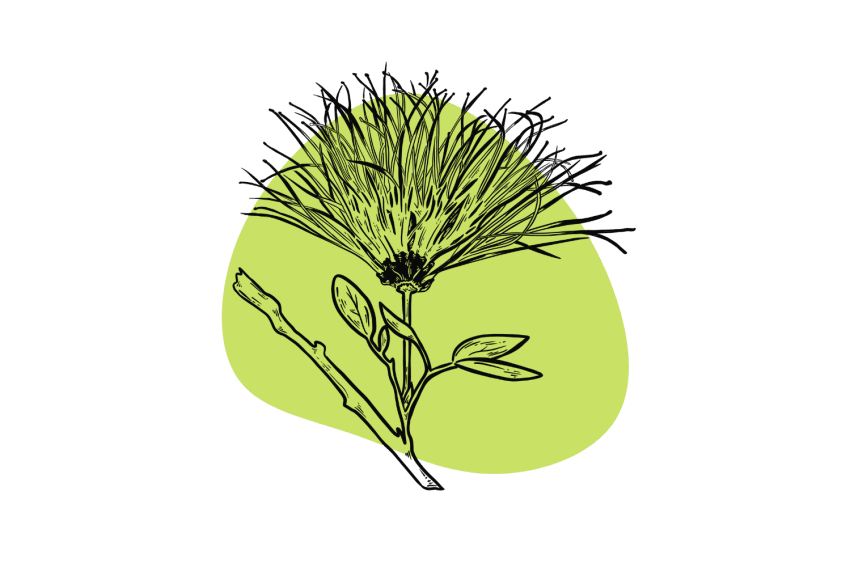Bobinsana: The Amazonian Mermaid
Bobinsana or Calliandra angustofolia is a leguminous shrub native to the Amazon Basin used by indigenous cultures as medicine and as a plant teacher in shamanic dietas.

Bobinsana (Calliandaria angustifolia) is an important medicinal plant from the Amazon. It’s used as a shamanic dieta — which involves consuming small amounts of the plant every day over the course of several weeks or months. Various rituals are also employed to connect with the “spirit” of the plant.
Bobinsana is a plant teacher — used to impart lessons involving emotional control, love, and connection.
Tribes throughout the Amazon basin have used bobinsana as an acute medical treatment for conditions including arthritis, contraception, and anxiety.
The bobinsana shrub can grow four to six meters tall and is most recognizable for its puffy pink flowers. The shrub enjoys a warm, wet environment and is quite rare outside the Amazon basin in South America.
What is a Bobinsana Dieta?
Bobinsana is not a psychoactive plant.
However, when taken daily during plant dietas, often in combination with ayahuasca. Many respect bobinsana as a powerful medicine and spiritual guide in the Amazon.
These dietas can last for days, weeks, months, or longer in some cases, under the guidance of a shaman who has experience with the plant.
Bobinsana is a commonly dieted plant in the form of tea, paste, or sometimes tincture — most often made from the shrub’s bark.
To experience the medicine of bobinsana, participants follow restrictive diets and are usually placed in isolation during the dieta.
Dietas are an ancient practice of ayahuasceros, and vegetalistas. They’re used to establish relationships with various plants. During a dieta, the user consumes small amounts of the plant throughout the day and spends time growing, harvesting, and meditating with the plant.
From a shamanic perspective, this practice enables users to connect with the spirit of bobinsana. By establishing a relationship with the plant, the belief is a student receives knowledge and healing.
Plant dietas are very subtle and unique processes across individuals. However, bobinsana has a reputation for helping participants connect with their emotions and love. For this reason, this plant is often referred to as “heart medicine.”
People who employ bobinsana dietas often report:
- Compassion
- Dealing with loss
- Empathy
- Grounding
- Improved communication
- Processing sexual trauma
- Womb healing
While these outcomes represent possibilities, understanding exactly how a bobinsana dieta will affect an individual is difficult to predict.
The plant has feminine energy and is often called a mermaid or siren. It’s often associated with the pink river dolphins of the Amazon.
Bobinsana has connections to water and emotion, which can be understood by listening to songs about bobinsana, like “Sirenita Bobinsana.” Working with these symbols and energies are common reference points when navigating a bobinsana dieta.
What is Bobinsana Good For?
Outside of dietas, bobinsana plays a role throughout the Amazon as herbal medicine. Bobinsana’s range spreads across Peru, Ecuador, Colombia, Brazil, and Bolivia.
Depending on the region, different tribes use different parts of the bobinsana plant for different purposes.
For example, ethnobotanist Richard Evans Schultes recorded in The Healing Forest along the Rio Pastaza in Colombia that an infusion of Calliandaria angustifolia roots provides an energizing tonic.
In Ecuador, bobinsana is used as a tonic to increase courage. It is also a remedy for diarrhea and skin problems and induces vomiting (emetic) [1].
In the Peruvian Amazon, as documented in the Chazuta Valley, various tribes use bobinsana for conditions including [2,3].
- Arthritis treatment (Rheumatic)
- Back pain (Analgesic)
- Blood cleanser (Depurative)
- Broken bones
- General health tonic
- Inflammation (Anti-inflammatory)
- Post-pregnancy as a tonic
- Pregnancy prevention (Contraceptive)
Although difficult to find in academic references, bobinsana is regarded as being able to induce lucid dreams, particularly during a dieta process. It’s believed that bobinsana transmits teachings through dreams.
Does Bobinsana Have Side Effects?
Bobinsana is generally considered safe, and adverse side effects are not expected in most people using it.
However, some reports from the Takawasi ayahuasca center in Peru mention bobinsana can cause musculoskeletal pain and dizziness.
Because of the anecdotes of bobinsana as a contraceptive, it’s suggested that pregnant women or those trying to get pregnant should avoid it. As a contraceptive, bobinsana daily may prevent pregnancy — but it is not a “morning after” treatment.
It’s also worth noting that bobinsana as a contraceptive isn’t documented in Western terms. This shouldn’t be a serious option without the guidance of an experienced practitioner. There is currently no scientific evidence to support the idea that bobinsana is useful as a contraceptive.
How to Take Bobinsana
Depending on the dieta and the shaman, the amounts of bobinsana taken varies. There’s no specific dosage range for this particular plant.
With that said, about 1 cup of bobinsana tea is typical for those practicing a dieta. The tea is usually consumed once in the morning and again in the evening before bed.
Bobinsana (Calliandaria angustifolia) Phytochemistry
There are a couple of studies done about the chemical constituents of bobinsana and related Calliandaria species [4]. But a comprehensive analysis does not exist.
Early research suggests the following active ingredients in bobinsana:
- Cyclooxygenase or COX inhibitors — A Swedish study investigated bobinsana’s widespread use for arthritis and found an indication of COX inhibition [5]. The specific compounds causing this effect are not named but are likely saponins.
- Pipecolic Acid — Isolation of 12 different pipecolic acid derivatives exists from Callindaria angustifolia, some showing signs of serotonin antagonism [6].
- Harmala Alkaloids (speculated) — Jonathan Ott, author of Ayahuasca Analogs, reports the addition of bobinsana to ayahuasca. This, along with a related plant, Calliandra pentandra, containing harmala alkaloid tetrahydroharmine (THH), has created speculation Calliandaria angustifolia could be somewhat psychoactive. THH works as a monoamine oxidase inhibitor.
How To Make Bobinsana Tea
Making bobinsana tea begins with harvesting the bark of a living tree. Make a small cut on one side of the tree carefully so as not to encircle the tree and kill it.
The bark is then peeled off in strips and placed in a large pot, and covered in water.
For several hours or even a few days, boil the tea down into a thick, almost syrupy tea or paste.
Throughout the process, a practitioner imbues the mixture with prayers and songs for the coming experience. If the tea is for a dieta, this is especially important.
Storage of the cool mixture is often in plastic bottles for later use.
Final Thoughts: What is Bobinsana?
Bobinsana is one of many Amazonian plants with a long and curious history of use. Using bobinsana in its traditional context — receiving teachings directly from the plant during a dieta — is a profound and healing experience for many. The stories and spirit of bobinsana are best understood with dietas facilitated by skilled practitioners with extensive experience with “the mermaid” and other plant allies like ayahuasca.
Understanding Calliandra angustifolia from a Western scientific lens is in its early stages. One hopes that the longstanding and wide-ranging medicinal uses known by tribes will inspire further investigation and appreciation for not only bobinsana but indigenous knowledge and wisdom alive today.
References
- Caballero-Serrano, V., McLaren, B., Carrasco, J. C., Alday, J. G., Fiallos, L., Amigo, J., & Onaindia, M. (2019). Traditional ecological knowledge and medicinal plant diversity in Ecuadorian Amazon home gardens. Global Ecology and Conservation, 17, e00524.
- Sanz-Biset, J., Campos-de-la-Cruz, J., Epiquién-Rivera, M. A., & Canigueral, S. (2009). A first survey on the medicinal plants of the Chazuta valley (Peruvian Amazon). Journal of Ethnopharmacology, 122(2), 333-362.
- Sanz-Biset, J., de la Cruz, J. C., Rivera, M. E., & Cañigueral, S. (2007). Ethnopharmacological survey of Chazuta valley (Peruvian Amazon): a potential source for anti-inflammatory herbal drugs. Planta Medica, 73(09), SL_005.
- Procópio, T. F., de Siqueira Patriota, L. L., de Moura, M. C., da Silva, P. M., de Oliveira, A. P. S., do Nascimento Carvalho, L. V., … & Napoleão, T. H. (2017). CasuL: A new lectin isolated from Calliandra surinamensis leaf pinnulae with cytotoxicity to cancer cells, antimicrobial activity and antibiofilm effect. International journal of biological macromolecules, 98, 419-429.
- Dunstan, C. A., Noreen, Y., Serrano, G., Cox, P. A., Perera, P., & Bohlin, L. (1997). Evaluation of some Samoan and Peruvian medicinal plants by prostaglandin biosynthesis and rat ear oedema assays. Journal of ethnopharmacology, 57(1), 35-56.
- Bejar, E., Amarquaye, A., Che, C. T., Malone, M. H., & Fong, H. H. (1995). Constituents of Byrsonima crassifolia and their spasmogenic activity. International Journal of Pharmacognosy, 33(1), 25-32.
